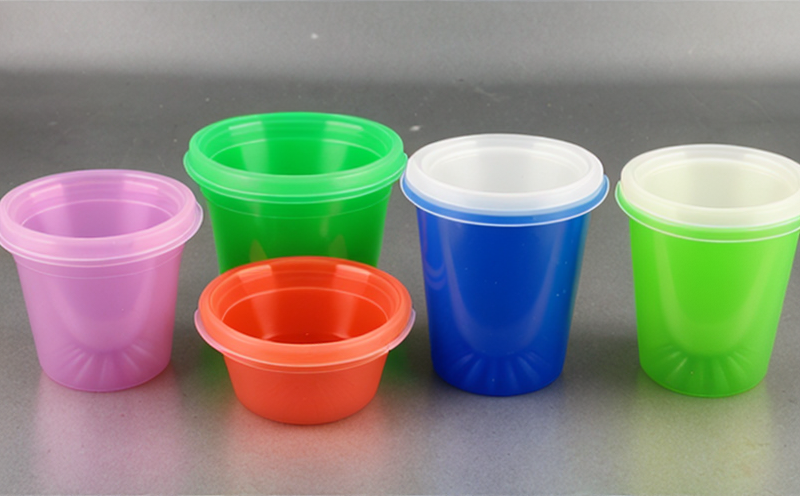JIS K 7127 Disposable Plastics Oxygen Permeability Testing
The JIS K 7127 standard is a critical tool used in the evaluation of disposable plastics, particularly those intended for packaging and food contact applications. This testing protocol measures the permeability of oxygen through plastic films and sheets, which is essential to ensure the integrity and safety of products that rely on controlled oxygen exposure.
Oxygen permeability directly impacts the shelf life and quality of packaged goods by controlling the rate at which oxygen can enter or escape from a package. For disposable plastics, this test ensures that the packaging meets regulatory requirements for protecting contents from spoilage due to oxidation processes. The test is especially important in sectors like food manufacturing, where maintaining freshness and safety is paramount.
The JIS K 7127 method involves placing the plastic sample between two chambers filled with nitrogen gas on one side and air on the other. The rate of oxygen transfer through the material is measured over a specified time period using an oxygen concentration sensor. This measurement provides data that allows for accurate assessment of the barrier properties of the plastic.
The standard specifies detailed procedures to ensure consistent and reliable results, including precise specimen preparation, temperature control during testing, and calibration of equipment. Compliance with JIS K 7127 is often a requirement in industries where product integrity and safety are critical, such as pharmaceuticals, medical devices, and food packaging.
Understanding the oxygen permeability of disposable plastics is crucial for optimizing packaging design to extend shelf life while ensuring that products remain safe for end users. This testing helps manufacturers make informed decisions about material selection and processing parameters, ultimately leading to more effective and safer packaging solutions.
Why It Matters
The importance of oxygen permeability testing in the context of disposable plastics cannot be overstated. Properly controlled oxygen levels are essential for maintaining product quality and safety. In food packaging, excessive oxygen can cause spoilage, leading to potential health risks. For medical devices, ensuring that the packaging does not allow significant oxygen ingress is critical for preserving the integrity of sensitive components.
By conducting JIS K 7127 testing, manufacturers can ensure their products meet stringent quality and safety standards. This testing helps in identifying any flaws or weaknesses in the packaging, thereby preventing issues such as early product spoilage, contamination, or degradation of materials. Moreover, compliance with this standard is often a legal requirement in many countries.
The results from these tests provide valuable insights into the performance of disposable plastics under various environmental conditions. This information enables manufacturers to make informed decisions about material selection and processing parameters, leading to more effective and safer packaging solutions. Ultimately, this testing contributes to consumer safety and satisfaction by ensuring that products remain fresh, safe, and functional for their intended use.
Scope and Methodology
| Parameter | Description |
|---|---|
| Test Specimen | The test specimen should be a representative sample of the plastic film or sheet. It must be free from defects that could affect oxygen permeability. |
| Environmental Conditions | Testing is conducted at controlled temperature and humidity levels to ensure consistency in results. |
| Gas Chambers | The specimen is placed between two chambers. One chamber is filled with nitrogen, while the other contains air. The oxygen concentration is monitored over time using an oxygen sensor. |
| Data Collection | Oxygen transfer rates are recorded at regular intervals to determine the permeability of the material. |
The JIS K 7127 standard provides comprehensive guidelines for conducting this test, including specimen preparation, equipment calibration, and data interpretation. Compliance with these protocols ensures accurate and reliable results, which are essential for making informed decisions about product design and quality control.
Benefits
- Enhanced Quality Control: Ensures that the packaging meets stringent quality standards, reducing the risk of product spoilage or contamination.
- Informed Material Selection: Provides valuable data for selecting appropriate materials with optimal oxygen barrier properties.
- Safety and Regulatory Compliance: Helps manufacturers meet legal requirements and industry standards related to food contact packaging and medical device manufacturing.
- Packaging Optimization: Allows for the optimization of packaging design to extend shelf life without compromising safety or functionality.
- Consistent Results: Standardized testing procedures ensure consistent results across different batches and production runs.
- Cost Efficiency: Early identification of potential issues through testing can prevent costly rework or product recalls.
The ability to accurately measure oxygen permeability is crucial for maintaining the integrity and safety of products that rely on controlled oxygen exposure. This testing ensures that packaging meets regulatory requirements, enhances shelf life, and protects against spoilage and contamination.





